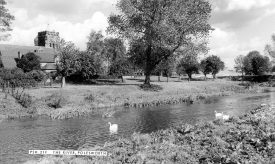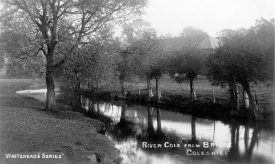In north Warwickshire, the jewel must surely be the River Anker. The Anker is a sparkling majestic delight which rises near the ancient village of Wolvey on the Leicestershire border near Watling Street and wends its slightly troubled, trolley-festooned way through Nuneaton town centre!
It soon regains its dignity once past Asda and making its way toward Weddington and Caldicote where, as it approaches Mancetter and Watling Street, its magnificence is released in the lee of Hartshill which rises in the south. Hartshill is flanked by woodland which now obscures the Oldbury hillfort, yet even here on the valley floor, one can sense Boudicca and her warriors, our Celtic ancestors, as their steeds are nervous and snorting and their tackle and weapons are clanging before the fight of their lives.
From Mancetter, the Anker heads north of Atherstone onto Polesworth where the wide clear Anker races under a road bridge and under the gaze of the tower of the Abbey church. Time stands still as one gazes at the trills and spills of the sparkling water at any time of year, glorious in its antiquity and assured of its place in our transient human landscape. Yet on the majestic Anker winds, quietly nourishing the rich farmland north of Polesworth and edges gleefully into Offa’s capital, Tamworth in Staffordshire. Here the Anker melds with the stately river Tame.
The Magnificent River Tame
Getting the train into Birmingham New Street from Coleshill in Warwickshire is a fairly tedious experience unless you happen to lift your head from your phone for a moment and look out of the window. There, suddenly is the magnificent River Tame. This glorious stream pushes its way under the railway track and seems to spiral around the train as it head southwest towards New Street. A heron is there momentarily but also moorhens and mallards teem on its surface, beneath all manner of life from otters to snails to bream, dab and pike.
It is astonishing that, as we hurtle though this sleepy post-industrial landscape, we encounter the wild Tame luxuriating in the place it has worn since the Ice Age! The Tame is surely the greatest of Warwickshire’s rivers and it makes its stately way to the Trent to the north and hence to the Humber and the sea.
The River Cole and River Blythe
In contrast the River Cole is a much more difficult river to love – yes, it is an ancient stream but it suffers from being obscured and alienated. Despite its proximity to Coleshill, the Cole flows west of the town in the scrap of wasteland between it and the M42 by Chelmsley Wood. It is at best three metres wide yet perseveres and nourishes the over farmed countryside on its banks. The Cole bends round Coleshill and there it feeds into a much more flamboyant character, the river Blythe.
At the foot of the hill on which stands the beautiful church of St Peter and Paul, Coleshill is a flimsy concrete and steel tube bridge over the Blythe. It has woven its way from Earlswood Lakes near Solihull past Blythe Hall, still the seat of the Dugdale family, great custodians of the history of Warwickshire and then under the Shustoke road to push through bulrushes into the wetlands shimmering south by the busy A452 and through Hampton in Arden and Barston until meandering back round finally to become part of the Tame, feeding the lakes at Kingsbury.
A wealth of beauty and natural wonder – this sacred landscape is constantly redeveloped and used and yet the sacred beauty remains. Yet, like Drayton, these rivers are mostly ignored and forgotten. Drayton was great friends with Shakespeare and he and Ben Johnson were with Shakespeare when, at 52, he took sick and died in April 1616. Michael Drayton the greatest poet since Shakespeare is now all but forgotten, like the rivers of Warwickshire.










Comments
Add a comment about this page